
Cooking Terms & Phrases You May Have Heard & What They Mean
Whether you enjoy watching cooking shows and shows about food, or you’re an at-home chef in your own kitchen, there are some terms and phrases related to cooking that you should know. These cooking terms you may have heard all have meaning and importance to what you do in the kitchen and when preparing food for the barbecue.
Cooking Terms & Phrases
A
Acid
Acids are a substance that can give away their hydrogen ions to another substance. They are characterized by a sour taste. When it comes to food, vinegar and citrus are great acids. So are apples, tomatoes, pineapple, and strawberries are considered acidic. Acids unwind protein bundles allowing moisture into food, which is why they are a great component to marinades.
Aging
This can be a dry or wet process.
Dry aging is when food is stored in a precisely controlled environment to cultivate flavor through the management of the enzymes in the meat’s cells. These enzymes break down protein, fat, and glycogen to form amino and fatty acids, one that is particularly important is glutamate – an essential part of Umami. Bacteria is also present during this process and will break down the muscle fibers of the meat and loosen up the collagen and connective tissues for a more tender final product. Dry aging is more expensive, and the end results reflect that.
Wet Aging is a less expensive process than dry aging. This is when meat is sealed in a vacuum package and sits in its own juices. It is not a bad process and will reflect on the price tag when compared to the dry aging process.
B
Bake/Baking
Baking is when foods are being cooked in a dry heat without being exposed directly to the heat source like a flame. When you cook in your oven or use indirect heating methods on the barbecue, you are likely baking.
Base
Bases accept hydrogen ions from acids and when it comes to cooking, they taste bitter. Pepper, curry, baking soda, and ginger are great examples of bases. Bases are used to neutralize acids and will form a water and/or salt as part of the neutralization process. When used in food, a base can provide lift for baked goods, reduce or remove sour or acidic flavors, and even aid in browning.
Bouquet Garni
This is a French term for a bundle of fresh herbs that is removed after cooking. Most bouquets include thyme, bay, parsley, and marjoram. However, variations include rosemary, basil, tarragon, and other fresh green herbs. Alternatively, a sachet – similar to a tea bag – with a combination of these herbs in dried format can be added. Either way, at the end of cooking, the bouquet is removed.
Braise/Braising
When you braise, you are cooking meat or vegetables that are partially submerged in flavorful liquid. There are two types of braising, long and short. Recipes that use this technique usually begin by searing the main part of the dish and then removing it. Then, flavorful ingredients are added to the pot - onions, vegetables, seasonings – for a little cooking, followed by a liquid. The main protein is added back in and partially submerged. A lid is placed over top for longer cooks, while shorter ones, featuring smaller cuts like chicken breast or thigh, may or may not have a lid. Braising larger cuts of meat that are high in collagen and connective tissues gives these generally tough things time to melt and become tender.

Thai Chicken Meatballs
This recipe for Thai Chicken Meatballs is a great example of a short braise

Upgraded Pot Roast
Long braises are great for larger cuts or when tenderness is the desired end result. This Upgraded BBQ Pot Roast Recipe is great for a Sunday dinner.
Brine/Brining
There are two types of brining. Dry and wet. Wet brining is what you are likely more familiar with. Salt itself is a fantastic mineral that will enhance certain flavors while counteracting bitter ones.
Wet brining uses a solution of 5 to 8 percent salt dissolved in water. Meat, seafood, and even vegetables are soaked in this solution for the purpose of rendering a more tender bite and increased flavor. Salt molecules are small enough to pass through the layers of foods causing them to absorb while becoming deeply flavored. Water is dragged into foods in an attempt to equalize the salt between the brine and food. The travelling salt brings water with it, decreasing moisture loss by up to 40 percent as heat is applied, the fibers of meat won’t contract as much or as quickly allowing that moisture to stay within the meat.
Dry brining is when food is salted and allowed to sit before cooking. Doing this brings moisture from the meat to the surface which liquifies the salt. This becomes a concentrated brine that is absorbed back into the meat, drying out the surface, which provides a better sear compared to something wet brined. Salting meat dissolves protein which will form a gel that will retain moisture. This is particularly helpful in larger cuts, however, this is also beneficial to vegetables that you wish to lacto-ferment.

Smoky Brined Pork Chops
Bringing can bring big flavor to your favorite meats. Try this recipe and enjoy some succulent pork chops.

Tomahawk Steak
This huge steak is a great example of dry brining. You can use the same technique for all of your steaks.
Brunoise
This is a very small dice, whereupon food has been julienned then turned and diced into the same width as the julienne, creating tiny cubes that are 1/8 inch (0.3 cm) or smaller.
C
Caramelization
This is the process where sugars are heated and oxidize, turning brown. The amount of heat that more refined or additional sugars can withstand will have a direct impact on the flavor of the final browning that happens when something caramelizes. Fruit and honey-based sugars begin caramelizing at temperatures as low as 230°F (110°C) while processed sugars – white sugar – caramelizes at 320°F (160°C). When including sweet flavors in your meals through rubs or sauces, as soon as heat is applied, the flavor will change.
Carryover Cooking
When you cook meat, the heat from the cooking surface moves into the meat, causing the molecules to become excited. This creates a difference in temperature throughout the meat, with the outer edges being the hottest and the temperature dropping rapidly as you move closer to the center. Even after removing the meat from the heat source, the warmth from the surface will continue to spread inward. This phenomenon is called carryover cooking. The amount of carryover cooking depends on the intensity of the external heat used during cooking. For instance, cooking a steak over an infrared burner will result in more significant carryover cooking compared to smoking the same steak.
Chop
This individual portioned meat cut is found and cut at 90 degrees from the spine of an animal. They usually contain a bone which is either part of the rib or the spine.
Chop/Chopping
Not to be confused with the cut of meat. Chopping is the act of cutting food. The desired size when one is instructed to chop is about ¼ inch (0.6 cm) or about the thickness of a normal (not fancy) pen’s grip. The best tool for this would be a chef’s knife.
Collagen
This connective tissue protein provides structure and strength to a muscle group. They coat the outer sheath of the muscle fiber as well as the bundles that the fibers are grouped in, to form what we know as the grain. Yes, the same grain that you are instructed to slice against when you cut meat. Collagen breaks down during the cooking process, however, collagen heavy cuts should be cooked slowly for optimum tenderness. This is because when heat is applied, collagen shrinks quickly and forces the moisture out of the cut you are cooking.
Connective Tissue
These tissues can be either the collagen sheaths of muscle fibers, tendons, silverskin, or ligaments. The amount and placement are dependent on the cut of meat you are preparing. The harder the muscle group worked; the more connective tissues will be found in the cut. Tendons, silverskin, and ligaments should be removed when cooking if at all possible.

Perfect Pulled Pork
Try this recipe for Perfect Pulled Pork if you want to see how tough cuts filled with connective tissue and collagen become the most tender bites when properly cooked.
D
Demi-glace
While the process to create a beautiful demi-glace is time-consuming, the end results are well worth the effort. Demi-glace is French in origin and used as the basis for many sauces and gravies. The deep flavors a produced by building a flavorful stock, straining said stock, then simmering the fresh stock with a brown roux and spice sachet that contains peppercorns, bay, and thyme. This combination is reduced by half, deeply concentrating the flavor. From there it can be seasoned to taste and utilized immediately or it can be divided and saved in the freezer until needed to add extra panache to your gravies, soups, stews, and more.
Denature
Denaturing is a process that modifies the chemical makeup of a structure. In this case we are talking about protein. When something is denatured, the weakest bonds in the chemical structure will be broken. This takes the highly ordered structure of protein and loosens it. This can occur through the use of salt, brine, and chemical means like marinade. It is also done through physical means like physical tenderization and cooking.
Dice/Dicing
Dicing is like chopping, only the cuts should be of a uniform size, about the size of a die or about ¼ of an inch across. Dicing ensures that this cut food will cook at the same or a similar rate and be ready to eat at the same time.
E
Emulsify/Emulsion
To emulsify is to combine two or more liquids that aren’t technically capable of mixing, like oil and water. An emulsion is the final result of this combination, usually a silky and creamy result. Great examples of this would be hollandaise sauce or carbonara. There are ways to help these liquids come together and stay together. Funnily enough it is through the addition of another liquid like tequila or vodka or the addition of soy lecithin or xanthan gum.
Enzyme
Enzymes are biological catalysts that are usually proteins. They help with chemical reactions in the body. Fruits like pineapple, papaya, and melon are high in enzymes that are used to digest. Other foods high in enzymes are kimchi and miso. They break down the muscle fibers and the collagen directly when brought into contact with food. This can create incredible marinades and fantastically flavorful foods that are succulent. However, they can also change the overall texture on the outside of foods as the surface is broken down.

Eggs Bene-Duckt
Try making your own emulsions with this recipe for Homemade Eggs Bene-Duckt
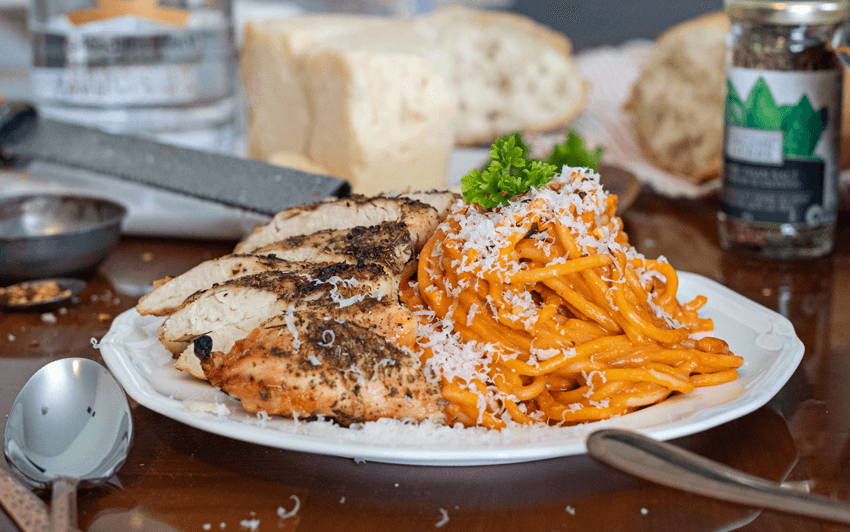

Wagyu Steak
Try making your own mayonnaise or Caesar dressing and experience the ultimate emulsification.
F
Flambe
This is the process where one ignites alcohol until the flames go out (flambé), it burns off approximately 25 percent of the alcohol. This is done for the purpose of caramelization and to add the flavor of the alcohol without the lingering bite of the booze. Flambe is also very exciting when done tableside, adding unique flair to desserts and even burgers, however, this technique is generally used in the kitchen or at the grill before food is presented. The ideal drinks that are used for flambe are cognac and rum, but anything over 40 percent (80 proof) will do. Wine and beer are too low in alcoholic content and anything higher than 40 percent (80 proof) are considered dangerous by professionals.
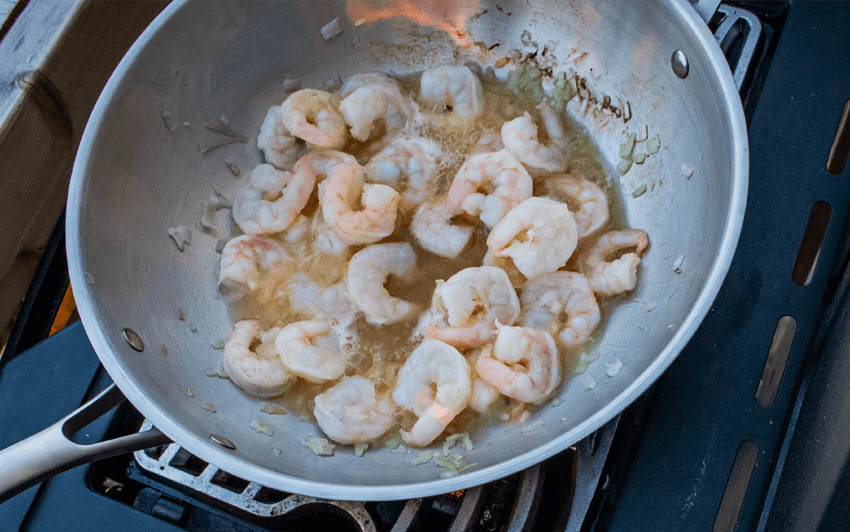
Flavor/Flavour
Flavor of anything is the entire experience encompassing what you are consuming. The physical taste as it hits your tongue, combined with the scent as you breathe it in, as well as the texture or textures as you chew. Flavor is the experience, not just what something tastes like.
Fermentation
Fermentation is a chemical process that breaks down organic substances like glucose thanks to enzymes found in yeasts. This has been done for centuries upon centuries. It is a process that can produce alcoholic beverages or lactic acid which gives you things like pickles and yogurt.
G-J
Giblets
Giblets consist of the heart, liver, neck, gizzard, and lungs of poultry. They are either removed entirely, removed and left loose within a whole bird, or in a pouch within the cavity of a whole bird. These parts are ideal for adding intense flavor to your soups and gravies as they can be seared off, along with the neck, wings, and pope’s nose (tail), then simmered in water with other stock making ingredients.
Julienne
Not just a pretty name, Julienne is a cutting technique that creates matchsticks of food. The fruit or vegetable in question is squared off at the ends, then cut into planks. Those planks are cut into strips that are then cut into smaller strips that resemble matchsticks.
L
Lacto Fermentation
To lacto-ferment something, items must either be submerged in a brine – a solution of water and salt or salted enough that they naturally release enough of their own juices to create a brine. This brine kills bad bacteria while the probiotic (good) bacteria will thrive. This good bacteria converts any present sugars into lactic acid – which is where you get the lacto part of lacto-ferment. This process makes foods taste tangy instead of pickled. While pickling is a very similar process, there is a key difference. When lacto-fermenting the sour or tangy flavor is from the act of fermentation, instead of using an acid to produce the sour flavor.
Leavener
Also known as levening agents or rising agents, these substances create carbon dioxide bubbles when combined with heat, acids, or liquids. They help baked foods rise or make textures lighter in baked goods. The most common ones would be baking soda and baking powder. Whipped cream and egg whites, instant yeast, and even sourdough starter are other examples.
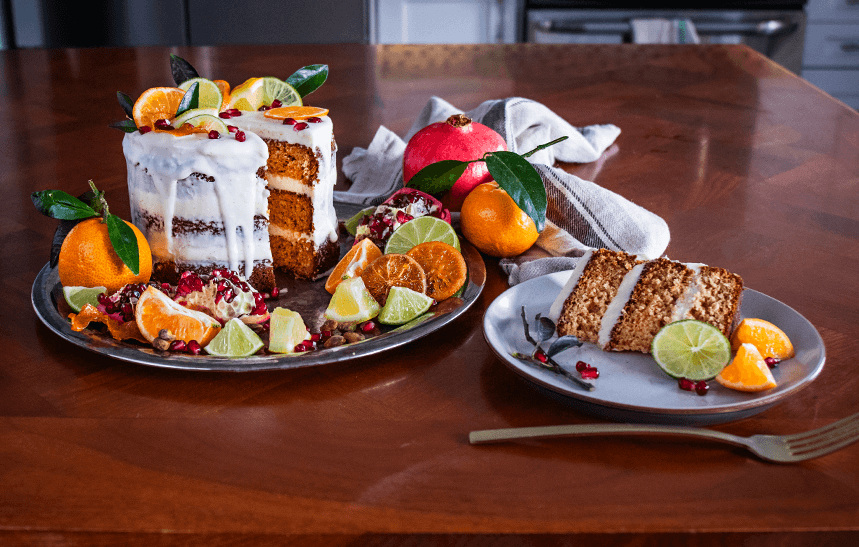
Spice Cake
Use a leavener to make delicious cakes on your barbecue like this Spice Cake with Cream Cheese Frosting and Fruit.
M
Macerate
Maceration is a marinating process where fruit is softened and the natural juices are drawn out, similar to when you salt something. However, instead of salt, granulated sugar or flavorful liquids like liquor are used. In the case of sugar, liquid inside the fresh fruit is expelled and combines with any sugar that hasn’t been absorbed by the fruit to create a syrupy liquid. When using wine or liquor the fruit will absorb the liquid, plumping – in the case of any dried fruit and deepening flavors.
Maillard Reaction
The process of browning when the heat from whatever you are using to cook breaks down the amino acids in the food being cooked. These amino acids react to the sugars present in the food and that causes browning.
Meis en Place
Another French term, this means “everything in its place”. This is something that they do in restaurant kitchens and will definitely set you up for recipe success when practiced at home too. Gather and prep the necessary ingredients and equipment for any given recipe before you begin cooking. That way, everything is at hand while you are cooking.
Mirepoix
Used in a great many things, this is a combination of carrots, celery, and onion that have been diced and cooked down slowly in butter without reaching that caramelization or browning. Their rich flavor is perfect for the beginnings of soups, stews, and braised dishes, but is generally strained out before the end of cooking. It is also known as Soffritto, the Italian term for the same mixture, but not to be confused with sofrito.
Mount
This is a shortened version of the French cooking term Monter au Beurre. It is when you finish a sauce or puree, off heat, with cold butter. The effect is lavish, producing something that is rich and creamy and glossy. The butter is whisked in and creates an emulsion of the sauce.
P
Pickling
Is the use of an acidic brine to preserve and build flavor into foods. Vinegar, water, and salt are the main ingredients used in this process, although lemon juice and sugar water have been used as well. Foods are then submerged in this mixture, that can include fresh herbs, garlic, and peppercorns, and placed into an airtight container for a period of time.

Pineapple Teriyaki Sliders
Perfect for topping recipes like Teriyaki Poutine, these Quick Pickled Onions are a fast, easy, and delicious condiment for all of your dining needs.
R
Reduce
When you reduce something, it’s most likely a liquid like a stock or sauce. Reduction happens when you bring this liquid to a boil or simmer in an uncovered pan. The amount of liquid will decrease and flavor will concentrate and become stronger. Depending on what’s in the liquid, it may become thicker in the case of a gravy or syrupy when a sugary liquid like wine or balsamic is reduced.
Roast
Cooking your food, most commonly meat, over a fire or in an enclosed space at temperatures of over 400°F (200°C), using dry heat, for extended periods of time is called roasting. Roasting should create caramelization and the Maillard reaction on all surfaces which is quite desirable.
Roux
The base of many thickened sauces, a roux is a combination of equal parts flour and fat – preferably butter, but duck and goose fat are fantastic substitutes, oil and beef tallow can also be used. Once the butter and flour have cooked together until the flour smell is gone, stock, cream, or milk are used to create a silky sauce. Roux has variations which are based on how long the flour and butter are cooked down. They range from white, cooked for only 5 minutes and used to thicken soups and sauces, to dark brown, cooked for up to 35 minutes and used for curries and gumbo. The darker the roux base, the less thickening power it has.

Eight Cheese Macaroni & Cheese
Use a roux to make this amazing Eight Cheese Macaroni & Cheese Recipe!
S
Sachet
Much like the bouquet garni, this is used to add flavor to soups, stews, broths, and braises. Instead of herbs tied together and removed after cooking, this is a pouch of spices and herbs that is tied into a bundle of cheesecloth.
Sear
Searing is when you use high heat to brown the surface of food. The best examples of this are when you use the Infrared Sear Station Side Burner to begin cooking the perfect steak dinner or when you use the cast iron griddle. The flavorful crust that is developed is the foundation for the delicious meal you are making and concentrates the Maillard reaction in the areas of direct contact with the heated surface.
Silverskin
Another connective tissue that is made of Elastin. Also known as gristle, it is unpleasant to eat and cannot be rendered or cooked out. Remove as much as possible before cooking. Silverskin also shrinks when cooked which will change the shape of the meat you are preparing.
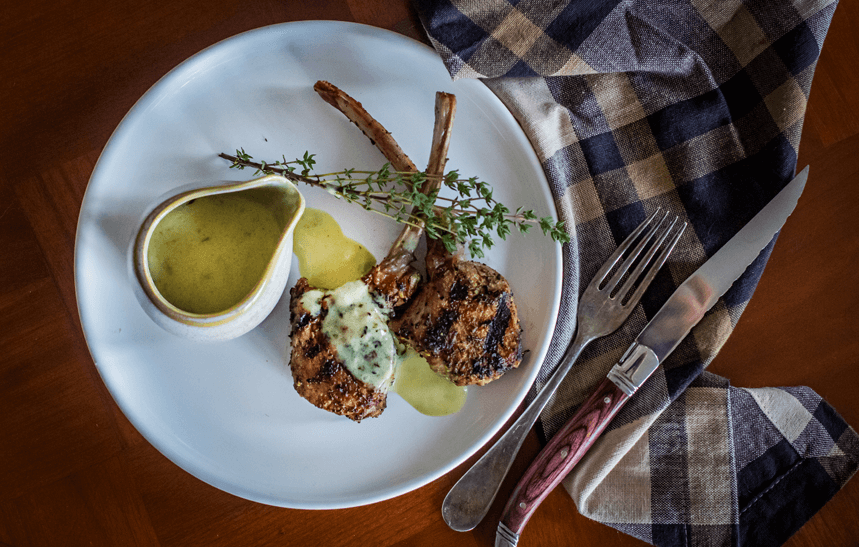
Lamb Lollipop
Sear these lamb lollipops using the SIZZLE ZONE™ Side Burner for a luxurious meal.

Smash Burger with Cheese and Pork Belly
Sear the perfect smash burgers on a griddle for the best burger experience you have ever had.
Slow Cooking
Usually done in an indoor appliance bearing the same name, slow cooking takes place using low heat for long periods of time. This infuses flavors into foods and keeps them succulent but can lead to overcooking and strange textures if the food is left unattended. When you slow cook on your barbecue or grill you are likely using indirect or smoking techniques. These use dry-er heat, instead of braising and simmering techniques typically used in the appliance. This also ensures that the end results are more delightful.
Soffritto
Not to be mistaken for the French Mirepoix, though it uses the same combination of aromats, Soffritto is diced and uses olive oil to brown the veg before they become the base for delicious meals. This can also be called Battuto as well.
Sofrito
Not to be mistaken for the Italian Soffritto, Sofrito is Spanish and usually includes garlic, bell peppers, onion, and tomato paste with the carrots, onion, and celery. It also sometimes includes fatty meats like pancetta.
Sous Vide
Another French term, this one means under vacuum. This is because food is sealed into containers, usually a bag, and as much air as possible is removed before the bagged food is submerged into a strictly controlled water bath. A special cooking device circulates water around the food in a tub or pot. This is another slow cooking technique that can control the final results of food in a very precise manner. Taking anywhere from 1 to 36 hours or more, this cooking method uses the water to bring food to the final temperature of the water and no further. This means that said meal can be held at this temperature without the food becoming overcooked for a little time as well. The only shortcoming of sous vide cooking is that the finished texture of foods can be a little lacking. To counter that, your barbecue is key. Most recipes will take this into account, however, be prepared to undercook a sous vide meal, so that it can be finished with a sear using high heat like the Infrared Side Burner.
Stir Fry
Stir frying is a thousands of year old cooking technique that is easiest when using a wok. A small amount of oil is heated to a high temperature and foods are quickly fried using a stirring or tossing motion to keep everything moving.
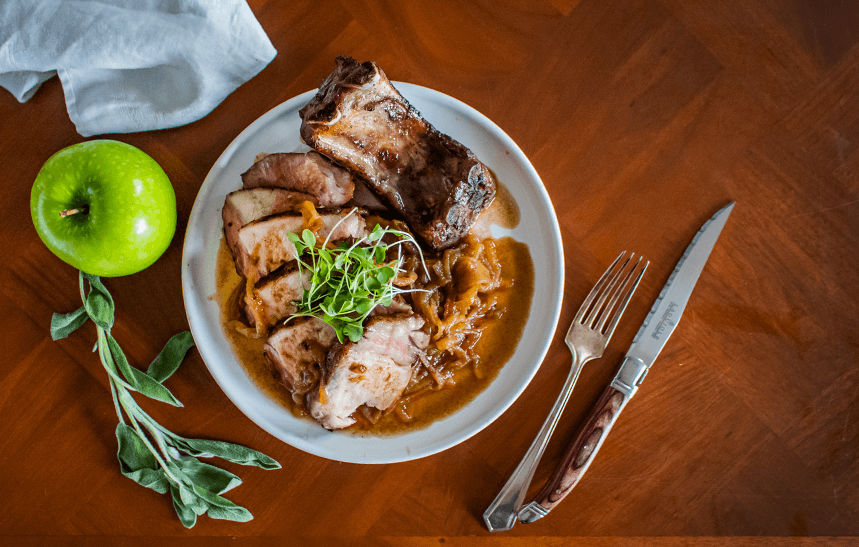
Sous Vide Steakhouse Porkchops
If you have a sous vide cooker, try this recipe for the most succulent and flavorful Steakhouse Style Porkchops.
T
Taste
There is a huge difference between the taste and the flavour of the things you consume. Taste is purely the physical action of detecting the food as you eat. The responses your tongue and soft palate provide indicate what you are experiencing, salty, sweet, sour, etc. They provide feedback that is combined with fragrance and texture to let you know the flavor of what you are eating.
Temper/Tempering
To temper something is to carefully heat or cool food to ensure that it doesn’t cook or curdle. It is the act of bringing two liquids to a similar temperature before fully combining them. Two great examples of this would be in a sauce you plan to thicken or when making homemade hollandaise sauce. For the sauce, mixing equal parts cornstarch and the hot liquid you plan on thickening before adding the resulting cornstarch slurry into the sauce would be tempering.

Pineapple Chicken Teriyaki
This recipe for Pineapple Chicken Teriyaki has a great example of using tempering to ensure a smooth and glossy, thick sauce. Not to mention that it’s delicious too.
Thermal Mass
This refers to something’s ability to retain and store heat. When related to cooking, thermal mass is important to your barbecue. How well does the unit as a whole heat up, retain that heat, and transfer it? Same with your cooking grids. You can also consider thermal mass when in the kitchen. Your pots and pans, how well they heat, distribute that heat, and store it. Cast iron is a great example of something that has high thermal mass. It will take longer to heat because it is storing more of that heat energy. But, it heats evenly and will take longer to cool as there is more energy to dissipate. Stainless steel has low thermal mass, but is able to retain and stabilize that energy efficiently.
Thermodynamics
Thermodynamics is the study of how energy works. There are a number of laws relating to how energy behaves.
The first law of thermodynamics states that energy remains constant. It cannot be created or destroyed, but it can be converted from one form to another. For instance, the light energy produced by flames, charcoal, and infrared burners is known as infrared radiation, which travels at the speed of light. When this radiation directly hits the food, it cooks through radiation. However, there are usually obstacles like sear plates and cooking grids that intercept the radiation. In such cases, the infrared radiation heats the surrounding metal and air, and this heat is then transferred to the surface of the food.
The second law of thermodynamics states that whenever matter undergoes a transformation from one form to another, there is a loss of matter, often in the form of heat. In the context of barbecue, everything wants to reach an equilibrium of temperature over time, due to heat transfer. Heat can only flow from a hotter object to a colder one, not the other way around. For example, when you place a cold steak onto a hot grill, the energy transfer occurs from the hot grill to the steak, displacing the coldness from the meat. Similarly, when you remove the steak from the grill, the heat in the steak displaces the coldness in the surrounding air. The sensation of feeling the heat radiating from the outside of your barbecue is another example of matter (heat) being lost.
U
Umami
The unique fifth taste that is becoming a buzz word in the culinary industry. Umami is more than just salty; it is a lingering sensation and is incredibly satisfying. Umami is produced by combining two of three chemical compounds in food – Glutamate, Inosinate, and Guanylate. You are already creating umami bombs or umami synergy when you cook. Adding cheese to tomatoes when you make pasta or tacos – that’s making umami.
Learn all about umami and building your own flavor sensations by reading our article about How to Build an Umami Bomb.
Got it Memorized?
After looking through this article, are you feeling more prepared to spend time in the kitchen and follow some advanced recipes? What did you learn and how did you use it? Share your stories, recipes, and photos with us on social like our Facebook and Tiktok pages using the hashtags #NapoleonEats and #NapoleonGrills.
